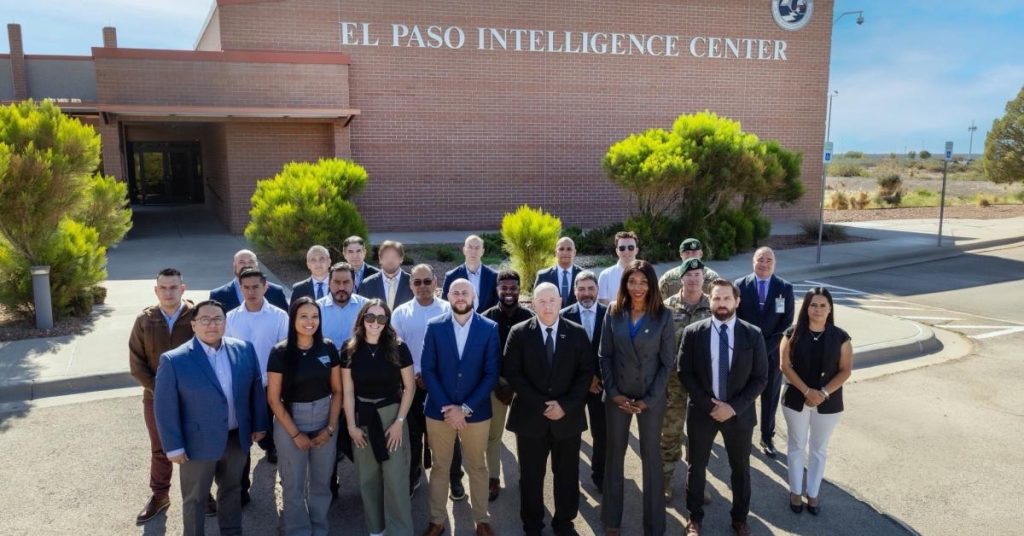The Defense Department and the DEA recently held a significant intelligence-sharing event with Mexican security forces in Texas. This effort highlights the Trump administration’s ongoing commitment to tackling the drug cartels notorious for trafficking illegal drugs and people, including many vulnerable women and minors, across the southern border. Sources from within the U.S. defense establishment, who preferred to remain anonymous, confirmed these efforts took place just across the Rio Grande in western Texas.
A senior defense official emphasized the unprecedented level of cooperation among various agencies to fulfill President Trump’s goal of halting the deadly drug flow that claims countless American lives each year. This official underscored the Pentagon’s dedication to securing the Southern Border and dismantling what he referred to as “the godless cartels.” The collaboration took place at the DEA El Paso Intelligence Center, known as EPIC, where U.S. federal agencies and Mexican security forces worked together.
The defense source described the event as a joint training mission designed to enhance real-time information sharing and coordinated planning against cartel activities. Mexican security forces participated in several briefings aimed at strengthening the collaboration against cartels operating within Mexico and smuggling drugs into the U.S. Defense Secretary Pete Hegseth has prioritized securing the southern border, establishing Joint Task Force – Southern Border, and deploying thousands of U.S. troops along the border.
Another senior defense official, who also preferred anonymity, highlighted the DEA’s role in hosting the information-sharing event at EPIC. The gathering included representatives from the DEA, DoD, and Mexican security forces, all working towards a common goal. The event provided participants a clearer understanding of the operational environment and resources available under President Trump’s executive orders.
The DEA describes EPIC as a collaboration site for 21 participating agencies focused on identifying threats to the nation, particularly along the Southwest border. This intelligence hub is an all-threats center with a special emphasis on the Western Hemisphere and the Southwest border. A defense source further noted that the U.S.-Mexico training mission aligned with the priorities of Trump and Hegseth in countering cartels threatening U.S. national security.
The Defense Department, according to the source, leads this mission with a strong emphasis on interagency collaboration. Key Trump administration figures, including Hegseth, DEA Administrator Terrence Cole, FBI Director Kash Patel, and DHS Secretary Kristi Noem, are directly involved. Two executive orders issued by Trump on Inauguration Day guide these efforts.
The first executive order designates cartels and similar organizations as Foreign Terrorist Organizations and Specially Designated Global Terrorists. It argues that international cartels pose a significant national-security threat beyond traditional organized crime. The order describes the cartels as entities controlling illegal traffic across the southern border through violence and terror.
The directive from Trump insists on eliminating these organizations’ presence in the U.S. and their capability to threaten American safety through extraterritorial command structures. The second order, titled “Securing Our Borders,” stresses the urgent need for border security to protect the American people from the adverse effects of illegal mass migration. Trump vowed to use all available resources to halt the influx of illegal aliens into the country.
The Defense Department stated that U.S. troops have been collaborating with Customs and Border Protection since January to seal the southern border. This initiative, named Joint Task Force-Southern Border, is managed by U.S. Northern Command and involves deploying thousands of troops to secure the U.S.-Mexico border. The U.S. military took control of the “New Mexico National Defense Area” in April, linked to Fort Huachuca in Arizona.
Defense Secretary Hegseth visited this National Defense Area later in April, emphasizing the administration’s commitment to defending American soil. Hegseth declared, “Under this administration, we defend our soil,” emphasizing the military’s role in detaining and prosecuting those attempting to enter the U.S. illegally. The U.S. military then assumed control of the “Texas National Defense Area” in May, associated with Fort Bliss in Texas.
Pentagon spokesman Sean Parnell reported last month that the task force had conducted over 3,500 patrols. This includes more than 150 joint operations with CBP and the Mexican military. The Defense Department remains steadfast in its mission to secure the southern border and counter the threats posed by drug cartels.



